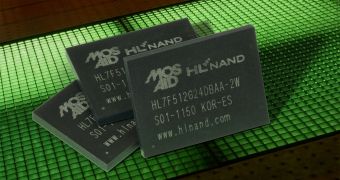Solid state drives have come a long way in the past couple of years, but Mosaid might just make it possible for them to cover just as much ground in a single leap.
Sure, that may be laying it on a bit thick, but there is something particularly noteworthy about a NAND module that can give major boosts to both performance and capacity.
By NAND module, we mean the first ever NAND Flash MCP (multi-chip package) with a 16-die NAND stack that relies on a single high-performance channel.
Its capacity is 512 Gb, hence its full name of 512Gb HLNAND MCP, where HLNAND is short for HyperLink NAND.
A stack of 16 standard 32 Gb NAND Flash dies are combined with two HLNAND interface devices.
The result is a data transfer of 333 MB/s on a single byte-wide HLNAND interface channel at 1.8V, all without power termination resistors.
By comparison, common NAND Flash MCPs cannot stack more than four NAND dies without having to sacrifice performance (would need two or more channels).
In layman terms, all this means that Mosaid Technologies has just offered a means to create solid state drives with capacities of one Terabyte (or more) and a speed of one GB/s and above.
“HLNAND confers distinct performance and form factor advantages,” said Peter Gillingham, vice president and chief technology officer at Mosaid.
“Using HLNAND technology, system engineers can design Gigabyte per second bandwidth and Terabyte capacity solid state drives (SSDs) with a single controller chip. Competing designs utilizing industry standard NAND MCPs will require multiple controller chips.”
Until a new SATA interface appears, Mosaid's inventions will probably be too good for anything but PCI Express SSDs. That doesn't take away from the milestone though.
“The 16-die stack 512Gb HLNAND MCP demonstrates the superior scalability of HLNAND’s ring architecture compared to the parallel bus architecture used in industry standard NAND Flash products,” said Jin-Ki Kim, vice president of research and development at Mosaid.
“HLNAND’s ring architecture allows a virtually unlimited number of NAND die to be connected on a single channel without performance degradation.”

 14 DAY TRIAL //
14 DAY TRIAL //